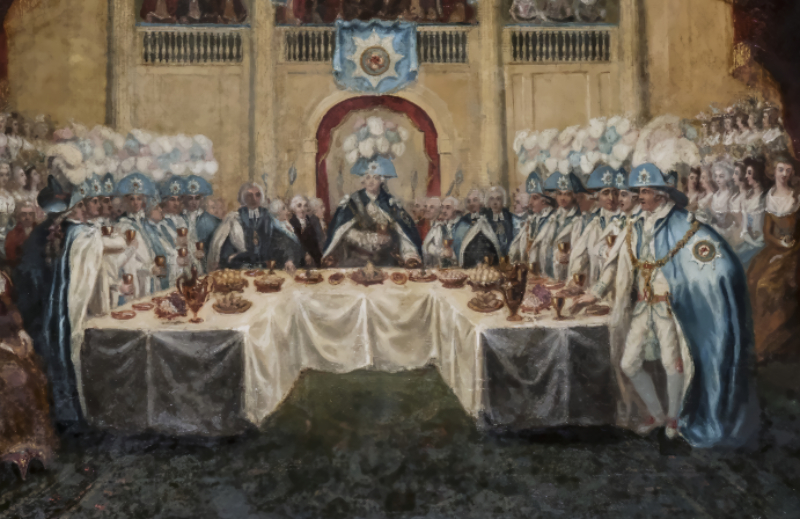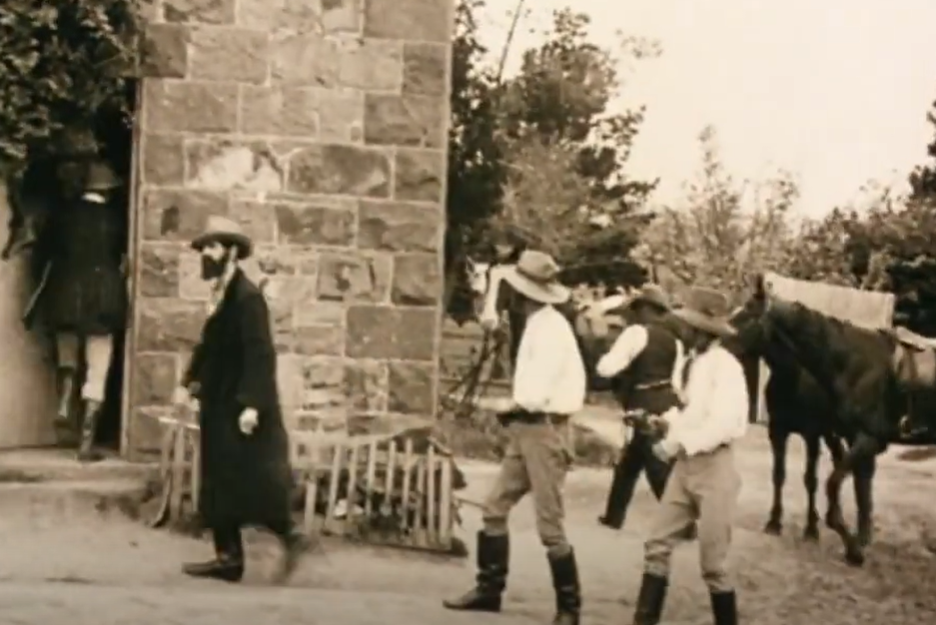Missing In Action
It’s one thing when your keys go missing, but over the course of history, many incredibly valuable and significant items have mysteriously disappeared—from crown jewels to Faberge eggs to an entire room (!)—and they’re still missing today.

The Isabella Stewart Gardner Museum Artworks
The Isabella Stewart Gardner Museum is a must-visit art museum, displaying an impressive collection of paintings, sculptures, tapestries, and decorative arts—all housed in a stunning building punctuated by a breathtaking courtyard and garden. It was started by its namesake, an American art collector and philanthropist who wanted to share her collection with the public.
Sadly, that’s not the only people she shared it with.
 Andre Carrotflower, CC BY-SA 4.0, Wikimedia Commons
Andre Carrotflower, CC BY-SA 4.0, Wikimedia Commons
The Isabella Stewart Gardner Museum Theft
Remember in the film The Town, where Ben Affleck and Jeremy Renner dress up at cops in order to talk their way into the safe rooms of Fenway Park in order to rob them? Well, that wasn’t the first time a team dressed up at cops and robbed a Boston landmark. Yup, that’s exactly how the Isabella Stewart Gardner Museum theft happened.
How It Happened
On the night of March 18, 1990, two men dressed as policemen buzzed the door at the museum, saying that they’d been called for a disturbance and had to investigate. Eventually, they convinced the two night guards working to let them in and subsequently subdued them.
The Dutch Room
The thieves then entered the Dutch Room and violently smashed and cut some paintings out of their stretchers. They took a number of pieces from the room before moving on to other areas of the museum. In the 81 minutes that the thieves were in the museum, they took a total of 13 works of art valued at $500 million, including works by Rembrandt and Vermeer.
 Andre Carrotflower, CC BY-SA 4.0, Wikimedia Commons
Andre Carrotflower, CC BY-SA 4.0, Wikimedia Commons
What Happened To The Artworks?
It likely would’ve been nearly impossible to arrange a sale of such high-profile—and high-value—artworks, and no leads about potential culprits have ever panned out. Though 1990 doesn’t seem that long ago, nearly 35 years have passed since, and it’s possible they’ve passed on since.
As for the museum? They rehung the empty frames, as if they're waiting for their contents to one day return.
 Federal Bureau of Investigation, Wikimedia Commons
Federal Bureau of Investigation, Wikimedia Commons
The Amber Room
Few realms did luxury like the Russian Empire—and among their most impressive demonstrations of their wealth and power was the Amber Room, constructed in the 18th century in Catherine Palace in Tsarskoe Selo near St Petersburg.
 Alex 'Florstein' Fedorov, CC BY-SA 4.0, Wikimedia Commons
Alex 'Florstein' Fedorov, CC BY-SA 4.0, Wikimedia Commons
What Was In The Amber Room?
The Amber Room featured decorations covered in gilt—but most important, it featured panels made with roughly 1,000 pounds of amber. So…how does an entire room go missing?
 Branson DeCou, Wikimedia Commons
Branson DeCou, Wikimedia Commons
What Happened To The Amber Room?
Though the Amber Room survived the fall of the Russian Empire, they came under fire in 1941 when Russia—and the Catherine Palace—were overrun by the German forces. Soldiers disassembled the room and took its contents back to Germany, ostensibly for safekeeping, but they were never seen again.
It’s likely that they were destroyed—but if you’re curious what they looked like, the Catherine Palace now houses a recreation of the Amber Room.
 Chatsam, CC BY-SA 3.0, Wikimedia Commons
Chatsam, CC BY-SA 3.0, Wikimedia Commons

History's most fascinating stories and darkest secrets, delivered to your inbox daily.
Love’s Labour Won
There are records dating from the late 16th century that state that a new William Shakespeare play had been published titled Love’s Labour Won—which really makes it sound like a sequel to Love’s Labour Lost. There’s just one problem.
 BatyrAshirbayev98, CC BY-SA 4.0, Wikimedia Commons
BatyrAshirbayev98, CC BY-SA 4.0, Wikimedia Commons
What Happened To Love’s Labour Won?
Despite evidence that Love’s Labour Won was published in 1598 and that copies were still being sold or distributed until 1603, there are no surviving copies of the play. For this reason, Shakespeare scholars believe that the play that title refers to may actually be Much Ado About Nothing.
 Saebo, CC BY-SA 4.0, Wikimedia Commons
Saebo, CC BY-SA 4.0, Wikimedia Commons
The Ghent Altarpiece
If you’ve taken an Art History 101 course and they haven’t mentioned the Ghent Altarpiece—have you really taken an Art History 101 course? This 15th century work of art was painted by Hubert and Jan Van Eyck for Saint Bavo’s Cathedral in Ghent, Belgium. In particular, one panel of the altarpiece—titled the “Just Judges” panel—is what was stolen.
 Jan van Eyck, Wikimedia Commons
Jan van Eyck, Wikimedia Commons
What Does The Just Judges Panel Look Like?
The panel in question shows a host of characters on horseback, many with colorful red and blue costumes, and green-tipped hills and plateaus in the distance. It’s believed that one of the figures is Philip the Good, who was the Duke of Burgundy.
 Jan van Eyck, Wikimedia Commons
Jan van Eyck, Wikimedia Commons
What Happened To The Just Judges Panel?
During the night of April 10, 1934, the panel was removed from its frame and stolen—a note in its place read “Taken from Germany by the Treaty of Versaille”, which recalled the fact that the panel had been taken by German forces during WWI only to have its return forced by the treaty afterward.
 Unknown Author, Wikimedia Commons
Unknown Author, Wikimedia Commons
The Ransom Note
Later that month, the Bishop of Ghent received a ransom note demanding 1 million Belgian francs. Another letter followed, and the Belgian government attempted to negotiate with the thief. One part of the panel was even returned as a show of good faith. But then, negotiations stalled.
 Hubert van Eyck, Wikimedia Commons
Hubert van Eyck, Wikimedia Commons
A Deathbed Confession
On his deathbed, a notable Belgian art thief claimed he was the only one to know where it is. A note he left his lawyer read that it “rests in a place where neither I, nor anybody else, can take it away without arousing the attention of the public”. Authorities even undertook an X-ray of the entire cathedral and 33 feet underneath it, but there was no trace of the painting.
Though investigations continue to this very day, little other compelling evidence has emerged.
 PMRMaeyaert, CC BY-SA 3.0, Wikimedia Commons
PMRMaeyaert, CC BY-SA 3.0, Wikimedia Commons
The Romanov Faberge Eggs
The Amber Room wasn’t the only thing that was lost in the aftermath of the Russian Revolution. For over 30 years, Russian jeweler Peter Carl Faberge created a series of bejeweled Easter eggs for the Romanov family, including 10 for Alexander III, and 40 for Tsar Nicholas II—who gave one each year to his wife and one to his mother.
Sadly, we all know how that story ends.
 greenacre8, CC BY 2.0, Wikimedia Commons
greenacre8, CC BY 2.0, Wikimedia Commons
The End Of The Romanovs
The Romanov family were rounded up and executed during the Russian Revolution in 1917. In the chaos that followed, seven of the eggs went missing, and it’s likely that each went on their own adventure. Evidence has shown that some may have made it to the US, while others have remained lost in the century-plus that has passed.
 Gryffindor, CC BY-SA 4.0, Wikimedia Commons
Gryffindor, CC BY-SA 4.0, Wikimedia Commons
The Ark Of The Covenant
The Hebrew Bible tells an intriguing tale of the gilded box that was created to hold the tablets engraved with the Ten Commandments. According to the story, it was kept in a temple built by King Solomon in ancient Jerusalem, a sacred site that was then sacked in 587 BCE by the Babylonians, led by King Nebuchadnezzar II.
 James Tissot, Wikimedia Commons
James Tissot, Wikimedia Commons
What Did The Ark Of The Covenant Look Like?
According to biblical accounts, the chest was large, made of gilded wood, and featured two angels on top with their wings outstretched to each other. Two poles, attached to the chest’s sides, would’ve been used to carry it. So…pretty much what it looks like in Indiana Jones and the Lost Ark.
 Paramount, Raiders of the Lost Ark (1981)
Paramount, Raiders of the Lost Ark (1981)
What Happened To The Ark Of The Covenant?
Though historians and amateurs alike have spent centuries discussing and trying to track down the Ark of the Covenant, many agree that even if it really did exist, it’s likely that it was either destroyed or decayed to the point of no return over the 3,000 years that have passed since it was constructed.
Or, if you believe the Indiana Jones films, it’s in a government warehouse somewhere.
 Benjamin West, Wikimedia Commons
Benjamin West, Wikimedia Commons
The Irish Crown Jewels
The history of the crown in Ireland—entwined as it has been with the crown of England—is fraught, to say the least. In 1831, a bejeweled badge and star were created for the Grand Master of the Order of St Patrick, meant to be an equivalent to the Order of the Garter in England and the Order of the Thistle in Scotland.
 Unknown Author, Wikimedia Commons
Unknown Author, Wikimedia Commons
Who Owned The Irish Crown Jewels
When William IV revised the Order of St Patrick in 1831, he decreed that new regalia should be created and given to the Grand Master of the Order—usually, the Lord Lieutenant of Ireland. He provided 394 stones from Queen Charlotte’s English Crown Jewels and her husband George III’s Order of the Bath star.
 James Lonsdale, Wikimedia Commons
James Lonsdale, Wikimedia Commons
What Did The Irish Crown Jewels Look Like?
The badge featured a sky blue enamel background to represent Saint Patrick, emeralds in the shape of a shamrock, and rubies in the shape of Saint Patrick’s Cross. It also included a motto made from pink diamonds.
 Thomas Alfred Jones, Wikimedia Commons
Thomas Alfred Jones, Wikimedia Commons
Was It An Inside Job?
It’s possible that the theft of the Irish Crown Jewels was planned years before it happened. In 1903, they were moved to a bigger safe during a move of the Office of the Arms within Dublin Castle—but the bigger safe didn’t fit in the room it was destined for, and it ended up in the office of Sir Thomas Vicars, the Ulster King of Arms.
Vicars was known for overdoing it. In a story, perhaps apocryphal, Vicars woke up after a night of drinking to find he was wearing the jewels. Was it a silly mistake—or an attempted robbery?
 John Keyse Sherwin, Wikimedia Commons
John Keyse Sherwin, Wikimedia Commons
What Happened To The Irish Crown Jewels?
In June of 1907, Vicars opened the safe that held the crown jewels to show to a visitor. That was the last time they were even seen. In July of 1907, as Dublin Castle prepared for a visit from King Edward VII and Queen Alexandra, the safe was again opened—and this time, the jewels were missing, along with some of Vicar’s family jewels and five collars of members of the Order.
 Library of Congress, Wikimedia Commons
Library of Congress, Wikimedia Commons
Who Stole Them?
Once they realized the jewels were gone, there was a massive blame game. Vicars refused to participate in the investigation, instead claiming his second in command did it. Rumors and theories spread. Some pointed the finger at various aristocrats, while the aristocrats blamed Irish Republicans—an easy target.
No matter who the culprit was, one thing was for sure—they were gone, and they haven’t been seen since.
 Dublin Police, Wikimedia Commons
Dublin Police, Wikimedia Commons
The Very First Feature Film
There are many lost films out there—as in, most films from the silent era, some 75%. Unfortunately, one of these is the world’s first feature film in history. It was called the Story of the Kelly Gang, depicting the misadventure of Ned Kelly, the Australian outlaw, and his gang. Kelly was a folk hero, and the film was a massive success in Australia.
 J. and N. Tait, The Story of the Kelly Gang (1906)
J. and N. Tait, The Story of the Kelly Gang (1906)
The Controversy
The film was ground-breaking for many reasons. Beyond being the first movie that long, it also caused one of the first moral panics over a film, with claims that it caused criminal behavior throughout the country, which resulted in censorship.
 J. and N. Tait, The Story of the Kelly Gang (1906)
J. and N. Tait, The Story of the Kelly Gang (1906)
The Problem With Film
Another thing that separates this film from other entries on the list? Sadly, it wasn’t lost to theft, which might mean that it’s sitting in some safe somewhere—it was lost to negligence. Like so many other notable films from the silent era, it was not properly preserved, and its quality degraded so much over time that only small portions of the film still exist. Film historians have made attempts to preserve or restore what remains.
 J. and N. Tait, The Story of the Kelly Gang (1906)
J. and N. Tait, The Story of the Kelly Gang (1906)
The Jules Rimet Trophy
We may not “get it” here stateside, but soccer, AKA football, AKA the “beautiful game,” is the world’s most popular sport. So it’s not unsurprising that for the very first World Cup of soccer in 1930, a very special—and very beautiful—trophy was created.
 Post of Nicaragua, Wikimedia Commons
Post of Nicaragua, Wikimedia Commons
The Trophy
Though named for the founder of the World Cup, Jules Rimet, the trophy was sculpted by Abel Lafleur. It featured a figure representing the Goddess of Victory holding a geometric vessel above her head, all in gold. Once every four years, it was presented to the winner of the World Cup—but there was a twist.
 National Media Museum, Wikimedia Commons
National Media Museum, Wikimedia Commons
The Three-Time Rule
When the World Cup began in 1930, the Federation set out its rules—it would be awarded to the winning team every four years. But there was one caveat. The first team to win it three times would get to keep the original Jules Rimet trophy, and another would be created for subsequent World Cups.
 Brazilian National Archives, Wikimedia Commons
Brazilian National Archives, Wikimedia Commons
The First Attempt
In 1966, the Jules Rimet trophy survived its first attempted theft. It was taken from a hall in London, and was gone for an entire week—until one morning, a man named David Corbett who was walking his dog Pickles, found it on the street, wrapped in newspaper.
 Unknown Author, Wikimedia Commons
Unknown Author, Wikimedia Commons
For Keeps
For decades, different teams vied for the Jules Rimet trophy—and finally, after 40 years, someone won it. For keeps. At the 1970 World Cup, Brazil won for the third time, earning them the right to keep the Jules Rimet trophy for good. However in 1983, it was stolen again—this time, also for good.
 Fabio Rodrigues Pozzebom, CC BY 3.0 BR, Wikimedia Commons
Fabio Rodrigues Pozzebom, CC BY 3.0 BR, Wikimedia Commons
The 1983 Theft
The trophy was stolen in 1983—but there’s something about this case that separates it from the others in this article. The suspects were apprehended. They were Sérgio Pereira Ayres, a banker, an ex-policeman named Francisco Rivera, and a decorator named José Luiz Vieira. When they were apprehended, fingers were pointed at an Argentine gold dealer—but there was just one problem.
 Abel Lafleur, CC BY 2.0, Wikimedia Commons
Abel Lafleur, CC BY 2.0, Wikimedia Commons
All That Glitters
Though there were claims that the trophy had been melted into gold bars, a more informed thief would’ve known that was impossible—the trophy was actually made of gold-plated silver. Though the culprits were caught and sentenced, they all fled the country, but each either perished or was re-arrested later. Despite that, the trophy was never recovered.
The Florentine Diamond
The Florentine Diamond was an absolutely massive yellow diamond—137 carats, to be exact—that had a contested history. It’s believed to have come from India, and it somehow ended up in Europe—though no one is sure exactly how.
 Chris 73, CC BY-SA 3.0 , Wikimedia Commons
Chris 73, CC BY-SA 3.0 , Wikimedia Commons
Charles The Bold
One story—perhaps just a myth—states that Charles the Bold, a Duke of Burgundy in the 15th century, had it cut from a larger stone and was so obsessed with it that he carried it with him everywhere…including into battle, and was said to have it on him when he perished in the Battle of Nancy in 1477.
 Rogier van der Weyden, Wikimedia Commons
Rogier van der Weyden, Wikimedia Commons
The Middle Years
For the next few centuries, the Florentine Diamond passed between noblemen, royals, and popes—including stints in two infamous families, the Sforzas and the de Medicis. But really, there are few accounts of the stones “lost years,” so to speak, until 1657. At that point, it was in the possession of Fernando de Medici, the Grand Duke of Tuscany.
 Manuelarosi, CC BY-SA 4.0 , Wikimedia Commons
Manuelarosi, CC BY-SA 4.0 , Wikimedia Commons
From Dynasty To Dynasty
The diamond then was passed from the de Medicis to the Habsburgs, where it was added to their collection of crown jewels. It was then added to an ornament for a hat. It was widely admired and plaster casts and replicas were made. The Habsburg dynasty became the Habsburg Empire—but in time, all empires fall.
 Justus Sustermans, Wikimedia Commons
Justus Sustermans, Wikimedia Commons
The Last Days Of The Austro-Hungarian Empire
During WWI, Emperor Charles I of the House of Habsburg-Lorraine was deposed. While fleeing to Switzerland, he took the stone with him and put it in a bank vault. He trusted one man, Bruno Steiner, a lawyer, to take care of it, and the other items he’d fled with it. It was a brutal mistake.
 Unknown Author, Wikimedia Commons
Unknown Author, Wikimedia Commons
The Diamond Vanishes
Steiner was supposed to help Charles sell it and other jewels so that the now-jobless former emperor could support himself. Unfortunately, at some point in those intervening years, it disappeared. There were reports in 1924 that Steiner was detained for and went to trial, where he was acquitted of fraud.
 Unknown Author, Wikimedia Commons
Unknown Author, Wikimedia Commons
Where’s The Florentine Diamond Today?
Either way, there’s been neither hide nor hair of it since—and sadly, since the diamond was so large and too high-profile to sell, it’s likely it was cut into smaller sto















